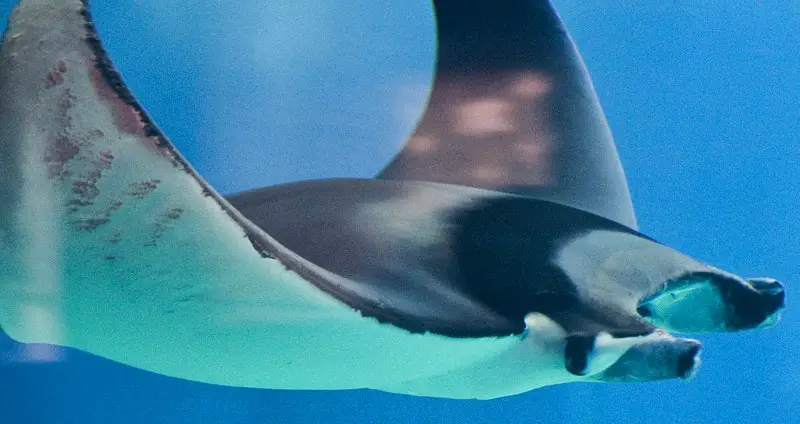The Devil Fish, also known as the Giant Devil Ray or Mobula mobular, is a species of ray that’s a part of the family Mobulidae.
This massive ray is present in several different regions, has a surprisingly friendly personality, and is facing endangerment and, potentially, extinction.
Read on to learn more about the massive Devil Fish that may not be gracing the sea with its presence for much longer.
Table of Contents
Devil Fish Appearance
This species is actually one of the largest rays in existence, taking the place of the largest ray in its genus Mobula.
The maximum recorded length of this ray was 17 feet, or 5.2 meters — a length longer than its close cousin the Lesser Devil Ray.
These rays are colored black-ish blue or brown on top, and their undersides are white with scattered black spots.
The head of the Devil Fish contains a pair of prominent cephalic fins that are often curled and give the appearance of horns.
These cephalic fins are similar to the ones present in the Alfred Manta Ray and the Giant Oceanic Manta Ray. The difference between these species, though, is that those rays have their mouths on the tip of their head while the Devil Fish’s mouth is lower down.
They possess several other fins, including pelvic and pectoral fins, and their tails are very long and are covered in spines.
Habitat/Distribution of the Devil Fish
This ray is most commonly found in the Mediterranean Sea, but it’s been found in a variety of other areas, too. Such areas include the Eastern Atlantic Ocean, the Northwest Atlantic, off the southwest coast of Ireland, and south of Portugal.
Croatia, Greece, Italy, and Turkey have all recorded encounters with this species.
The Mobulidae family of rays is known for preferring deep, open waters as opposed to the ocean floor, and the Devil Fish is no exception to this.
These rays are commonly found in deep coastal waters, but they’re sometimes seen in shallower waters.
The Italian National Institute for Environmental Protection and Research tagged 3 Devil Fish and recorded their depths. While they would sometimes dive to over 2000 feet, they mostly stayed under 165 feet.
Additionally, they have a preference for warmer water that’s between 68°F and 84°F. This pension for warm water sees them migrate across the Mediterranean Sea as the seasons change.
Devil Fish Behavior/Personality
In other studies focusing on ray distribution, researchers found that Devil Fish spend the majority of their time either alone or in small clusters. Occasionally, they form larger groups of up to 18 rays.
Therefore, this is a relatively social species, but it can and does survive just fine on its own.
Devil Fish Diet
One reason behind why the Devil Fish doesn’t dive very deep for long periods of time is likely because it’s scouting out its food from above.
This species primarily feeds on euphausiid shrimp, or Meganyctiphanes norvegica, and various small fish from the Clupeidae family and Mesopelagic region.
In order to hunt, the Devil Fish uses its massive wingspan to cover its prey and trap them using their branchial plates, or their gill covers.
This diet is fairly standard for rays.
Reproduction of Devil Fish
This species of ray has a slow reproductive cycle and procreates very infrequently. Although a Devil Fish’s lifespan is around 20 years, it can’t produce many offspring in that time.
Mobula mobular is an ovoviviparous species, meaning that it produces its young through eggs that are hatched within their own body and held inside until they’re slightly grown. Because of this, females can birth one child at a time, although two are occasionally birthed together.
The entire process is estimated to take right around 2 years.
Birthing is most common in the summer months, and babies feed off of their mother’s milk until they’re able to hunt on their own.
Are Devil Fish Endangered?
As of November 20, 2018, the IUCN Red List classifies the Devil Fish as endangered with a declining population trend. It was originally classified as vulnerable in 2004, but was reclassified in 2006 due to high bycatch mortality and low reproductive rates.
The Devil Fish is extremely vulnerable to bycatch. Most deaths are at the hands of swordfish nets, but they also fall victim to trawls, trammel nets, tuna traps, purse seines, and longlines.
This bycatch, coupled with environmental damage through industrial gabage and solid waste, has worked to slowly reduce their population.
They aren’t always caught inadvertently, though. Fisheries all over the world are known to target Mobula rays for recreation and consumption. Gaza and Egypt specifically target Devil Fish for consumption.
Fortunately, there are active efforts to protect the Devil Fish in Italy, Croatia, and Albania. It’s also protected under the Bern and Barcelona conventions.
Despite their slow reproduction timeline, if conservation efforts are enhanced further, Devil Fish have the potential to come back and become as populous as ever.


